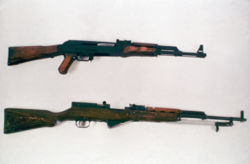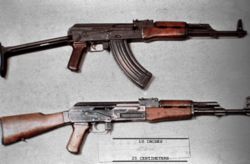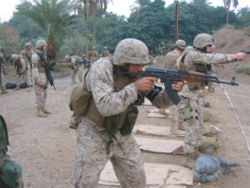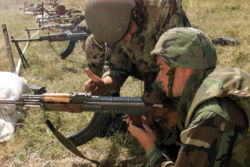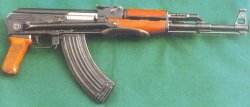AK-47
2007 Schools Wikipedia Selection. Related subjects: Military History and War
| AK-47 | |
|---|---|
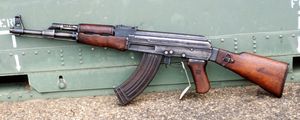 A Type 2 AK-47, the first machined receiver variation. |
|
| Type | Assault rifle |
| Place of origin | Soviet Union |
| Service history | |
| In service | 1949— |
| Used by | Soviet Union, many others |
| Production history | |
| Designer | Mikhail Kalashnikov |
| Designed | 1947 |
| Number built | Over 100 million |
| Variants | AK-47, AKS, AKM, AKMS, RPK, AK-74, AK-101, AK-102, AK-103, AK-107, AK-108 (See table below for national-production variants) |
| Specifications | |
| Weight | 3.8 kg (9.5 lb) empty, 4.3 kg loaded |
| Length | 870 mm (34¼ in) |
| Barrel length | 415 mm (16.3 in) |
|
|
|
| Cartridge | 7.62 × 39 mm |
| Action | Gas-operated, rotating bolt |
| Rate of fire | 600 rounds/min |
| Muzzle velocity | 710 m/s (~2,330 ft/s) |
| Effective range | 300 m (330 yd) |
| Feed system | 30-round detachable box; compatible w/ RPK 40-round box, 75-round drum magazine. |
| Sights | Adjustable iron sights, optional mount required for optical sights |
The AK-47 (shortened from Russian: Автомат Калашникова образца 1947 года, Avtomat Kalashnikova 1947) is a gas-operated assault rifle designed by Mikhail Kalashnikov, and produced by Russian manufacturer Izhevsk Mechanical Works and used in many Eastern bloc nations during the Cold War. It was adopted and standardized in 1947. Compared with the auto-loading rifles used in World War II, the AK-47 was generally more compact, with a shorter range, a smaller 7.62 × 39 mm cartridge, and was capable of selective fire. It was one of the first true assault rifles and remains the most widely used and known. The AK-47 and its numerous variants and descendants have been produced in greater numbers than any other assault rifle and are in production to this day.
History
Design background
During the Second World War, Germany had developed the concept of the assault rifle. This concept was based on the knowledge that most military engagements in modern warfare were happening at fairly close range with the majority happening within 100 meters (110 yd). The power and range of contemporary rifle cartridges was simply overly powerful for a vast majority of engagements with small arms. As a result, a cartridge and firearm were sought combining the features of a submachine gun (high-capacity magazine and fully-automatic fire capability) with an intermediate-power cartridge that would be effective to a range of 300 meters (330 yd). For the sake of reduced manufacturing costs, this was done by shortening the 7.92 × 57 mm Mauser cartridge case and substituting a lighter bullet to create the 7.92 x 33 mm Kurz.
The resulting Sturmgewehr 44 (StG44) was not the first rifle to use these features; it was preceded by earlier Italian Cei-Rigotti and Russian Fedorov Avtomat designs. The Germans, however, were the first to produce and field a sufficient number of the type to properly evaluate its utility. They fielded the weapon in large numbers against the Russians towards the end of the war and this experience deeply influenced Russian doctrine in the years following the war.
Mikhail Kalashnikov began imagining his weapon while still in the hospital, after being wounded in the battle of Bryansk. He had been informed that a new weapon was required for the 7.62 × 41 mm cartridge developed by Elisarov and Semin in 1943. Sudayev's PPS43 submachine gun was preferred to Kalashnikov's design.
Design concept
Despite circumstantial evidence, Mikhail Kalashnikov denies that his rifle was based on the German assault rifle. It is best described as a hybrid of several previous innovations. To support his position, the AK-47 owes more to the M1 Garand Rifle than any German design. The double locking lugs, unlocking raceway, and trigger mechanism are clearly derived from the earlier American design. This is not surprising as millions of Garand rifles had operated reliably in combat around the globe. Though mechanically similar to the Garand, the AK-47 borrows its cartridge concept, weapon layout, gas system, and construction methods from the StG44. Further, the safety is surprisingly similar to the Browning-designed Remington Model 8 rifle.
The genius in the design of the Kalashnikov rifle is in the simplification of those contributing designs and adaptation to mass production. The AK-47 can be seen as a fusion of the best that the M1 Garand offered combined with the best aspects of the StG44 made by the best processes available in the Soviet Union at the time. Kalashnikov used clearances between parts that were much larger than clearances used in standard gun smithing practice, contributing to the non-jamming characteristics of the AK-47.
| The operating mechanism of the Kalashnikov family of weapons is basically very similar to that of the US M1 and M14 rifles and M1/M2 carbines. In fact, as is often the case in a successful weapon design, there is little new about the individual elements of Kalashnikov’s design; the inventor’s accomplishment was in the recombination of known elements into a compact, reliable and durable package. — Ed Ezell |
Receiver development history
There were many difficulties during the initial phase of production. The first production models had stamped sheet metal receivers. Difficulties were encountered welding the guide and ejector rails causing high rejection rates. Instead of halting production, a heavy machined receiver was substituted for the sheet metal receiver. This was a more costly process, but the use of machined receivers accelerated production as tooling and labor for the earlier Mosin-Nagant rifle's machined receiver were easily adapted. Partly because of these problems, the Soviets were not able to distribute large numbers of the new rifle to soldiers until 1956. During this time, production of the interim SKS rifle continued.
Once manufacturing difficulties had been overcome, a redesigned version designated the AKM (M for modernized or upgraded—in Russian: Автомат Калашникова Модернизированный) was introduced in 1959. This new model used a stamped sheet metal receiver and featured a slanted muzzle brake on the end of the barrel to compensate for muzzle rise under recoil. In addition, a hammer retarder was added in order to prevent the weapon from firing out of battery (without the bolt being fully closed) during rapid or automatic fire. This is also sometimes referred to as a "cyclic rate reducer", or simply "rate reducer", as it also has the effect of reducing the number of rounds fired per minute during automatic fire. It was also lighter than the previous model, roughly two-thirds of the weight. Both licensed and unlicensed production of the Kalashnikov weapons abroad were almost exclusively of the AKM, partially due to the much easier production of the stamped receiver. This model is the most commonly encountered, having been produced in much greater quantities. All rifles based on the Kalashnikov design are frequently referred to as AK-47s in the West, although this is only correct when applied to rifles based on the original 3 receiver types. In most former Eastern Bloc countries, the weapon is known simply as the "Kalashnikov". The photo at right illustrates the differences between the Type 2 milled receiver and the Type 4 stamped, including the use of rivets rather than welds on the stamped receiver, as well as the placement of a small dimple above the magazine well for stabilization of the magazine.
In 1978, the Soviet Union began replacing their AK-47 and AKM rifles with a newer design, the AK-74. This new rifle and cartridge had only started being exported to eastern European nations when the Soviet Union collapsed drastically slowing production of this and all other small arms.
| Receiver type | Description |
|---|---|
| Type 1A/B | Original stamped receiver for AK-47. -1B modified for folding stock. Namely, a large hole is present on each side to accommodate the hardware for the underfolding stock. (this naming convention continues with all types) |
| Type 2A/B | Milled from steel forging. |
| Type 3A/B | "Final" version of the milled receiver, from steel bar stock. The most ubiquitous example of the milled-receiver AK-47. |
| Type 4A/B | Stamped AKM receiver. Overall, the most-used design in the construction of the AK-series rifles. |
Features
The AK-47 is simple, inexpensive to manufacture and easy to clean and maintain. Its ruggedness and reliability are legendary. The large gas piston, generous clearances between moving parts, and tapered cartridge case design allow the gun to endure large amounts of foreign matter and fouling without failing to cycle. This reliability comes at the cost of accuracy, as the looser tolerances do not allow the precision and consistency that are required of more accurate firearms. Reflecting Soviet infantry doctrine of its time, the rifle is meant to be part of massed infantry fire, not long range engagements.
The notched rear tangent iron sight is adjustable, each setting denoting hundreds of meters. The front sight is a post adjustable for elevation in the field. Windage adjustment is done by the armory prior to issue. The battle setting places the round within a few centimeters above or below the point of aim out to approximately 250 meters (275 yd). This " point-blank range" setting allows the shooter to fire the gun at any close target without adjusting the sights. Longer settings are intended for area suppression. These settings mirror the Mosin-Nagant and SKS rifles which the AK-47 replaced. This eased transition and simplified training.
The bore and chamber, as well as the gas piston and the interior of the gas cylinder, are generally chromium-plated. This plating dramatically increases the life of these parts by resisting corrosion and wear. This is particularly important, as most military-production ammunition during the 20th century contained corrosive mercuric salts in the primers, which mandated frequent and thorough cleaning in order to prevent damage. Chrome plating of critical parts is now common on many modern military weapons.
Operating cycle
To fire, the operator inserts a loaded magazine, moves the selector lever to the lowest position, pulls back and releases the charging handle, and then pulls the trigger. In this setting, the gun fires only once (semi-automatic), requiring the trigger to be released and depressed again for the next shot. With the selector in the middle position (full-automatic), the rifle continues to fire, automatically cycling fresh rounds into the chamber, until the magazine is exhausted or pressure is released from the trigger. As each bullet travels through the barrel, a portion of the gases expanding behind them are diverted into the gas tube above the barrel, where they impact the gas piston. This in turn is driven backward, pushing the bolt carrier, which causes the bolt to move backwards, ejecting the spent round, and chambering a new round when the recoil spring pushes it back.
Disassembly
Dismantling the rifle involves the operator depressing the magazine catch and removing the magazine. The charging handle is pulled to the rear and the operator inspects the chamber to verify the gun is unloaded. The operator presses forward on the retainer button at the rear of the receiver cover while simultaneously lifting up on the rear of the cover to remove it. He then pushes the spring assembly forward and lifts it from its raceway, withdrawing it out of the bolt carrier and to the rear. The operator must then pull the carrier assembly all the way to the rear, lift it, and then pull it away. He removes the bolt by pushing it to the rear of the bolt carrier; rotating the bolt so the camming lug clears the raceway on the underside of the bolt carrier and then pulls it forward and free. When cleaning, the operator will pay special attention to the barrel, bolt face, and gas piston, then oil lightly and reassemble.
Ballistics
The standard AK-47 or AKM fires a 7.62 × 39 mm round with a muzzle velocity of 710 metres per second (2,329 ft/s). Muzzle energy is 1,990 joules (1,467 ft·lbf). Cartridge case length is 38.6 millimetres (1.5 in), weight is 18.21 grams (281.0 gr). Projectile weight is normally 8 grams (123 gr). The AK-47 and AKM, with the 7.62 × 39 mm cartridge, have a maximum effective range of around 300 meters (330 yd). For comparison, the 7.62 × 54 mm R cartridge has a projectile of 9.6–12 grams (148–185 gr), depending on the weapon, at a velocity of 818 metres per second (2,683 ft/s) for approximately 4,000 joules (2,950 ft·lbf) of energy.
Variants
Kalashnikov variants include:
- AK-47 1948–51, 7.62 × 39 mm — The very earliest models, with the Type 1 stamped sheet metal receiver, are now very rare.
- AK-47 1952, 7.62 × 39 mm — Has a milled receiver and wooden buttstock and handguard. Barrel and chamber are chrome plated to resist corrosion. Rifle weight is 4.2 kg.
- AKS-47 — Featured a downward-folding metal stock similar to that of the German MP40, for use in the restricted space in the BMP infantry combat vehicle.
- RPK, 7.62 × 39 mm — Squad automatic rifle version with longer barrel and bipod.
- AKM, 7.62 × 39 mm — A simplified, lighter version of the AK-47; Type 4 receiver is made from stamped and riveted sheet metal (see schematic above). A slanted muzzle device was added to counter climb in automatic fire. Rifle weight is 3.61 kg, due to the lighter receiver.
- AKMS, 7.62 × 39 mm — Folding-stock version of the AKM intended for airborne troops. Stock may be either side- or under-folding
- AKMSU, 7.62 × 39 mm — Folding-stock and shortened version of the AKM intended for airborne troops. Stock is under-folding and barrel is 35 cm long
- AK-74 series, 5.45 × 39 mm — See main article for details.
- AK-101 series
- AK-103 series
- AK-107/108 series
In 1978, the Soviet Union began replacing their AK-47 and AKM rifles with a newer design, the AK-74. This new rifle and cartridge had only started being exported to eastern European nations when the Soviet Union collapsed, drastically slowing production of this and all other small arms.
Production outside of Russia
Military variants only. If no link is provided, the difference is in name only, and all features and functions are identical to the Soviet equivalent model in parentheses. Summary of information presented in Poyer's The AK-47 and AK-74 Kalashnikov Rifles and Their Variations.
| Country | Variant(s) |
|---|---|
| Albania | Unknown. |
| Bulgaria | AKK (Type 3 AK-47), AKKS (Type 3 with side-folding buttstock) |
| AKKMS (AKMS) AKKN-47 (fittings for NPSU night sights) | |
| AK-47M1 (Type 3 with black polymer furniture) | |
| AK-47MA1/AR-M1 (same as M1, but in 5.56 mm NATO) | |
| AKS-47M1 (AKMS in 5.56 mm NATO), AKS-47MA1 (same as AKS-47M1, but semi-automatic only) | |
| AKS-47S (AK-47M1, short version, with East German folding stock, laser aiming device) | |
| AKS-47UF (short version of -M1, Russian folding stock), AR-SF (same as -47UF, but 5.56 mm NATO) | |
| AKS-93SM6 (similar to -47M1, cannot use grenade launcher) | |
| RKKS, AKT-47 (.22 rimfire training rifle) | |
| East Germany | MPi-K (AK-47), MPi-KS (AKS), MPi-KM (AKM), MPi-KMS72 (AKMS); |
| Egypt | AK-47, MISR 7.62 (AKM), Maadi |
| Hungary | AKM-63, AMD-65, AMD-65M, AMMSZ, AMP, NGM 5.56 |
| Iraq | Tabuk (M70B1, and M70AB2) |
| Tabuk sniper rifle (M70B1 with 23.6-inch barrel, optics, different stock) | |
| North Korea | Type 58A (Type 3 AK-47), Type 58B (stamped steel folding stock), Type 68A (AKM-47) Type 68B (AKMS) |
| China | Type 56 Rifle (not Carbine), Type 81, Type 87 |
| Poland | kbk AK/pmK (AK-47), kbk AKS (AKS), kbk Ak PNG60, kbk AKM (AKM), kbK AKMS), kbk wz. 88 Tantal (AK-74 with special side-folding stock), kbk wz. 96 Beryl |
| Romania | AI (AK-47), AIS (AKS), AIM, AIMS (AKM, AKMS), AIR |
| Yugoslavia | M70, M70A, M70AB2 M64 (AK-47 with longer barrel), M64A (grenade launcher) M64B (M70 w/ folding stock) |
Certainly more have been produced elsewhere, but the above list represents major producers and variants. An updated AKM design is still produced in Russia.
The basic design of the AK-47 has been used as the basis for other successful rifle designs such as the Finnish Valmet 62/76 and Sako Rk 95 TP, the Israeli Galil, the Indian INSAS and the Yugoslav Zastava M76 and M77/82 (not to be confused with the Barrett M82) rifles. Several bullpup designs have surfaced, although none have been produced in quantity. Bullpup conversions are also available commercially. For a complete list, see the List of weapons influenced by the Kalashnikov design.
Licensing
Russia has repeatedly claimed that the majority of these manufacturers produce AK-47 without a proper license from IZH. The Izhevsk Machine Tool Factory acquired a patent in 1999, preventing (in theory) the unauthorized manufacture of the Kalashnikov rifle system by anyone.
Legal status
In the United States
Private ownership of fully-automatic AK-47 rifles is tightly regulated by the National Firearms Act (NFA) of 1934. The Gun Control Act of 1968 ceased importing of foreign-manufactured fully-automatic firearms for civilian sales and possession, effectively halting further importation of civilian accessible AK-47 rifles. In 1986, an amendment to the Firearm Owners Protection Act stopped all future domestic manufacture of fully-automatic weapons for civilian use.
However, machine guns manufactured domestically prior to 1986 and imported prior to 1968 may be transferred between civilians in accordance with federal and state law. Several Soviet and Chinese rifles made it into the U.S. during the mid-1960s, when returning Vietnam veterans brought them home after capture from enemy troops. Many of these were properly registered during the 1968 NFA amnesty.
Nevertheless, several states have laws on their books outlawing private possession of fully-automatic firearms even with NFA approval. Certain semi-automatic AK-47 models were banned by the now-expired Assault Weapons Ban of 1994–2004.
In Canada
In Canada on January 1 1995, a new class of prohibited weapons was created (class 12.5) that included the AK-47 and its variants. This classification makes the AK-47 and its variants ordinarily illegal for purchase, acquisition, or import. Exceptions to this are the Valmet Hunter, the Valmet Hunter Auto, and the Valmet M78 rifles which are based on the AK-47 action. Individuals in Canada who possessed firearms in the 12.5 class prior to January 1 1995 were "grandfathered" into this class and thus can continue to acquire and possess the AK-47 and its variants.
In Europe
Much of Western Europe has enacted comprehensive national firearms laws which prevent the lawful ownership of AK-47s or variants thereof. The United Kingdom, for instance, has outlawed, through the Firearms (Amendment) Act 1988, semi-automatic centerfire rifles (See Gun politics in the United Kingdom for more complete information). It is possible to own AK derivatives in the UK provided they have been produced as "Manual Straight Pull" rifles which need to be manually cocked after each shot. This involves a modification to the weapon to essentially remove the gas system by permanently closing the gas port above the barrel (may also involve the removal of the gas piston).
In Norway it is forbidden for civilians to possess any form of fully automatic firearm unless a special permit is issued. Similar laws are in force throughout most of Europe. Fully automatic weapons are either explicitly or effectively outlawed in almost all of North America and Europe, as well as Russia, Japan, and Australia.
In Australia
In Australia, the purchase of semi-automatic centerfire rifles has been effectively banned since 1996 (See Gun politics in Australia for more information), and therefore AK-47 rifles, even in semi-automatic form, are not allowed. However, as the 1996 laws covered only high-capacity magazines, shotguns and rifles, AK-47s in pistol configurations remain legal for purchase in Australia.
In Mexico
In Mexico, its possession is of the exclusive use of the Mexican National Army. The federal firearms and explosives law prohibits the civilian possession of this category of weapon in its Article 11. However, the AK-47, known as cuerno de chivo (Spanish for "goat's horn"), is widely used by criminal organizations.
Illicit trade
Throughout the world, the AK-47 and variants are among the plethora of commonly smuggled small arms that are sold to governments, rebels, criminals and civilians alike, with little international oversight. This trade ensures a ready supply of inexpensive weapons to a number of conflicts, including (but certainly not limited to) the Balkans, Iraq, Afghanistan, and Somalia. In some countries that are recovering from war or that are at war, prices for AKs are very low. In Somalia, Rwanda, Mozambique, Congo and Ethiopia, among others, prices are between $30–$125.
Cultural influence
During the Cold War, the Soviet Union, China and the United States supplied arms and technical knowledge to numerous client-state countries and rebel forces to promote their interests. This period saw the proliferation, sometimes free of charge, of AK-47s by the Soviet Union and China to pro-communist countries and groups such as the Nicaraguan Sandinistas and Viet-Cong. The AK-47 design was spread to a total of 55 national armies.
The proliferation of this weapon is reflected by more than just numbers. The AK-47 is included in the flag of Mozambique and its coat of arms. It is also found in coat of arms of Burkina Faso and the flag of Hezbollah. " Kalash", a shortened form of " Kalashnikov", is used as a name for boys in some African countries.
In the U.S., movie makers often arm criminals, gang members and terrorist characters with AK-47s (e.g. films like Boyz N The Hood). Numerous computer games, video games, and rap songs feature AK-47s. Toy makers and the airsoft industry make millions of replica AK-47s.
